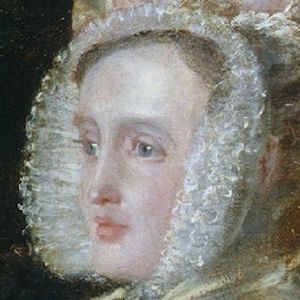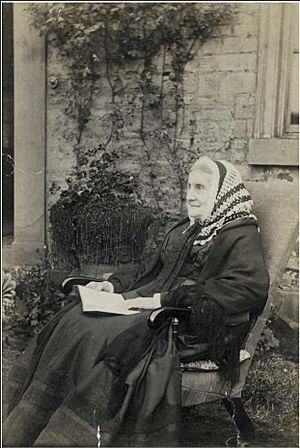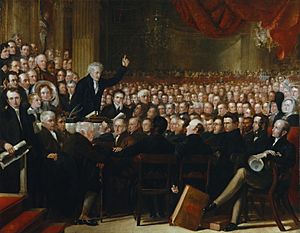Mary Anne Rawson facts for kids
Quick facts for kids
Mary Anne Rawson
|
|
|---|---|

Rawson in 1840.
|
|
| Born |
Mary Anne Read
1801 Sheffield, England
|
| Died | 1887 |
| Nationality | British |
| Occupation | Campaigner |
| Known for | Abolitionism |
| Spouse(s) | William B. Rawson |
| Parent(s) | Joseph and Elizabeth Read |
Mary Anne Rawson (1801–1887) was a dedicated British campaigner. She is best known for her work as an abolitionist, meaning she fought to end slavery. She also supported other good causes, like the Religious Tract Society and the British and Foreign Bible Society. Mary Anne Rawson also campaigned for Italian nationalism and against child labour.
She first joined a group in Sheffield that successfully encouraged people to boycott sugar. This sugar came from the West Indies and was made by enslaved people. Mary Anne Rawson is shown in a famous painting attending the World Anti-Slavery Convention in London in 1840.
Contents
Early Life and Family
Mary Anne Read was born in 1801 to Joseph and Elizabeth Read. Her parents were wealthy and lived at Wincobank Hall in Wincobank, a part of Sheffield. They encouraged her to get involved in helping others.
Her father, Joseph Read, ran a business that later became the Sheffield Smelting Company. He faced money problems and had to sell Wincobank Hall. Later, Mary Anne, who became a widow, was able to buy the hall back.
Her sister, Elizabeth, was married to William Wilson. He was the chairman of the Nottingham Anti-Slavery committee. Their son, Henry Wilson, later became a Member of Parliament. Henry and his brother made sure Mary Anne's wishes for Wincobank Hall were carried out after her death.
Fighting for Freedom: Abolitionism
From the mid-1820s to the 1850s, Mary Anne Rawson's main focus was fighting against slavery. She was a founding member of the Sheffield Female Anti-Slavery Society in 1825. This group worked to gain rights for enslaved people in the British Empire.
Campaigning for Immediate Change
The Sheffield society was special because it was the first to demand an immediate end to slavery. Other groups often wanted a gradual end. Mary Anne's society used talks and leaflets to encourage people to stop buying goods made by enslaved people. This included items like coffee and sugar from the West Indies.
The society officially closed after the Slavery Abolition Act was passed in 1833. This law ended slavery in most of the British Empire.
Continuing the Fight Worldwide
In 1837, Rawson became secretary of the Sheffield Ladies Association for the Universal Abolition of Slavery. This group continued to fight for enslaved workers around the world. Women's anti-slavery groups, first started by Lucy Townsend, were sometimes not taken seriously. However, new studies show these groups had a big impact across the country.
Mary Anne Rawson wrote letters to important figures like George Thompson in Britain. She also corresponded with Frederick Douglass and William Lloyd Garrison in the United States. Famous visitors to her home included Lord Shaftesbury and William Wilberforce.
With her mother, Elizabeth Read, as treasurer, Mary Anne was a key leader in the Sheffield Female Anti-Slavery Society. After her father's death and his financial difficulties, Mary Anne used her early widowhood to pay off his debts. She and her mother moved back into Wincobank Hall. Both women continued to be very active in politics and social causes.
The 1840 Anti-Slavery Convention
A famous painting shows Mary Anne Rawson at the world's first international anti-slavery conference in 1840. This event brought together delegates from many countries.
In the painting, all the women, except Mary Clarkson, are shown at the far right. None of them are in the main part of the painting. This is because women were not allowed into the main discussions of the convention. This rule caused problems with the American delegation, as they had many female abolitionists.
Women shown in the painting include Elizabeth Pease, Amelia Opie, and Lucretia Mott. After the convention, Mary Anne hosted important guests like Charles Lenox Remond and Nathaniel Peabody Rogers.
Wincobank Hall's Legacy
In 1841, Mary Anne Rawson and her sister, Emily Read, opened a day school. It was located in the chapel on the grounds of Wincobank Hall. The school welcomed local children. In 1860, the sisters set up a trust to pay for and manage the school. It continued to operate until 1905.
Later, Wincobank Hall was used by the Salvation Army as a 'rescue home' from 1899 to 1915. By 1921, the hall was in ruins. It was eventually torn down to build a housing area called the Flower Estate. All the streets there are named after flowers.
Today, the chapel at Wincobank Hall has been restored and is used by the community.
Personal Life
Mary Anne married William Bacon Rawson, who was a banker and iron founder from Nottingham. Sadly, their marriage was short because William died in 1829. Their only child, Elizabeth, passed away in 1862 at the age of 33.
Legacy
Mary Anne Rawson's work and life are remembered today. Indiana University's Lilly Library has a large collection of her letters and photographs. This collection also includes her watercolour paintings of Italy. The University of Sheffield holds some of her materials related to the poet James Montgomery.



